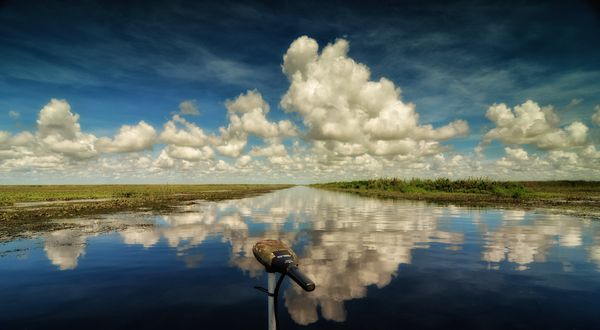Neutral density filter question
Dec 2, 2015 12:25:40 #
I'd like to try to get into long exposures since I now have a respectable tripod to put my camera on. As I understand it (or maybe not) an ND filter blocks the light that comes into it requiring a longer shutter speed, but if the sky is blown out and the ground is dark on a 1/250 sec exposure, wouldn't it still be overexposed/underexposed with a 30-second or minute exposure? The only thing that change would be smooth water. Also, looking at B&H and such it seems that anything decent will cost well over $100.
Dec 2, 2015 12:29:50 #
planepics wrote:
I'd like to try to get into long exposures since I... (show quote)
ND filters do not change the range of light, only darken everything by the same amount. Think of an ND filter as sunglasses for your camera. The ratio of brightness between dark areas and light areas stays the same.
--Bob
Dec 2, 2015 12:30:25 #
There are also graduated neutral density filters for the example you gave: bright sky, dark landscape. You are able to change the ratio of brightness that way.
Dec 2, 2015 12:32:47 #
In cases like this (high/low contrast) a graduated filter can work in addition to the ND filter.
As to the cost, you have el cheapo that will create a color shift and the very expensive one that will ALSO create a shift but much more subdued*.
To see the difference... If you have access to a brick and mortar store, ask to see both and place then on a white piece of paper.
---
* That shift is often caused by the light quality itself not the quality of the filter.
As to the cost, you have el cheapo that will create a color shift and the very expensive one that will ALSO create a shift but much more subdued*.
To see the difference... If you have access to a brick and mortar store, ask to see both and place then on a white piece of paper.
---
* That shift is often caused by the light quality itself not the quality of the filter.
Dec 2, 2015 12:38:31 #
Linda From Maine wrote:
There are also graduated neutral density filters for the example you gave: bright sky, dark landscape. You are able to change the ratio of brightness that way.
there are also reverse graduated filters too...for shooting sunsets near the horizon line.
Dec 2, 2015 12:39:07 #
What is the possility that an ND filter will not effect all wavelengths equally. A cheapy might not, maybe. So light wavelength shifts might be an issue but then the degree might be snall towards vanishing.
Dec 2, 2015 12:40:51 #
planepics wrote:
I'd like to try to get into long exposures since I... (show quote)
Yes, an ND filter won't fix the contrast difference between the highlights and shadows in your image.
And yes, a good ND filter is expensive. :)
What you CAN do is "black card" your exposure. That is, while you are ticking off the seconds of the exposure (lets pretend 20 seconds) you cover the top of the frame with a black card against the lens (let's pretend for 10 of those seconds) and then you remove it.
The effect you get is that the top of the frame is exposed more closely to the bottom and thus not blown out.
When you do this...you have to slightly move the card "jiggle" so that the line between the top and bottom is not noticeable.
Dec 2, 2015 12:41:02 #
As Linda pointed out, the grad ND's can help get control over the dynamic range by selectively darkening the bright areas while leaving the darker areas untouched.
I think pretty much all ND's will give a slight color cast which can be remedied in post processing. The better the ND, the less the color cast. You also will need several grad. ND's for the different conditions you will come across. They make hard and soft transitions which is how quickly the filter changes from full ND to full clear. I have several of the Lee ND's they probably rank up at the top but they are expensive and sometimes can be hard to get.
I think pretty much all ND's will give a slight color cast which can be remedied in post processing. The better the ND, the less the color cast. You also will need several grad. ND's for the different conditions you will come across. They make hard and soft transitions which is how quickly the filter changes from full ND to full clear. I have several of the Lee ND's they probably rank up at the top but they are expensive and sometimes can be hard to get.
Dec 2, 2015 12:41:50 #
As others have mentioned, an ND will not by itself change the ratio of light to dark in a capture. The suggestion of a graduated ND would help.
However, you might want to view the video that was linked just yesterday that shows how you can use multiple exposures, later combined in pp, to produce the soft/blurred water effect.
http://www.youtube.com/watch?v=YcZkCnPs45s
This method would save you the cost of a new filter if you are happy with the results.
However, you might want to view the video that was linked just yesterday that shows how you can use multiple exposures, later combined in pp, to produce the soft/blurred water effect.
http://www.youtube.com/watch?v=YcZkCnPs45s
This method would save you the cost of a new filter if you are happy with the results.
Dec 2, 2015 12:54:44 #
Dec 2, 2015 16:09:49 #
Unless you have a perfectly flat horizon line a gnd will either expose or cover spots that it shouldn't. Better to bracket and composite or use software to make your adjustments
Dec 2, 2015 16:49:20 #
Look at Cokin or lee P range of filters. they come with a holder that fits the lens (specify) The holder can take up to three filters. You can spin the holder so that you can adjust where the lighter shades are. you can also put a graduated filter upside down for a sunset. After that its up to you to judge how long to hold the exposure. Not necessarily the 'best' but then in awkward lighting they are a workable option.
Dec 2, 2015 17:58:06 #
This is my experience with GRADUATED N/D filters. The inexpensive ones are simply not suited to precise professional usage. Some of them have intrinsic color shifts, some of the plastic ones can cause interference (Morie) patterns when used in conjunction with other plastic filters, cause an unacceptable degree of sharpness loss and worst of all most are deficient in smooth enough gradations of tones to be applied subtly enough over a range of apertures.
One of my main requirements for theses filters is for use in window-light portraiture, especially in wedding photography. My basic rule is not to include the window in my composition in that it is simply the light source and has no aesthetic value in itself. On many occasions, however, there are beautiful bay windows with window seats, or others architectural features such as decorative iron work, interesting shapes and configurations, stained or leaded glass borders and many more interesting and appropriate decorative aspects that I want to include in my compositions. Oftentimes this situation requires a great deal of exposure differential correction between the subject and the light coming in through the window and/or the light being shed on the exterior landscape in the background. Depending on the time of day, exposure of the interior to the sunlight or skylight and the density of the window glass there are different degrees of neutral density that need to be applied.
Unfortunately enough, high quality filters, in general, are expensive and good graduated n/ds border on the outrageous. My 2 B+W models in large enough sizes to accommodate a 77mm diameter filter mount, set me back over $400. each and that was over 10 years ago. They are large rectangular filters made of anti-flare coated fine optical glass and fitted to an adapter that enables sliding the of the filter up and down or sideways so that it can be precisely adjusted as to where the neutral density is needed. For the window light usage that I described, I use the filter in a vertical orientation. I have also used them for some sky control in exterior architectural work. Usually, I prefer polarizing filters for intensifying skyscapes in architectural exteriors as long as the position of the elevations of the the building being photographed allows for the angle of the sun that is needed to effect polarization. Sometimes I need to visit the location several time to determine the bet time of day for the shoot. Every now and again, I find a situation where the front elevation of the building is never perfectly lighted for a compatible time where the sky and the building are both polarization friendly. When this is the case, I might employ one on my graduated n/ds. Sometimes, general polarizing may cause too much darkening of windows or can remove the desirable effect of reflections in bodies of water or decorative pools in the foreground of an architectural composition is another situation where a high quality graduated n/d filter can be applied.
Nowadays, what with automatic and manual white balance adjustments intrinsic in most DSLRs, large inventories of color correction and conversion filters are no longer necessary in most areas of photography. We can even manage with florescent lighting of so many different types, all manner of odd light sources or even ones with discontinuous spectrums. Whatever can not be addressed in the camera can usually be dealt with somewhat easily in PhotoShop or other editing systems. With all this in mind, I don't mind investing well in top-of-the-line versions of the relatively few filters that I still require. There is no sense in defeating the great degrees or sharpness, good contrast and acceptance of the fine lenses and camera bodies that we have already invested in.
Ed
One of my main requirements for theses filters is for use in window-light portraiture, especially in wedding photography. My basic rule is not to include the window in my composition in that it is simply the light source and has no aesthetic value in itself. On many occasions, however, there are beautiful bay windows with window seats, or others architectural features such as decorative iron work, interesting shapes and configurations, stained or leaded glass borders and many more interesting and appropriate decorative aspects that I want to include in my compositions. Oftentimes this situation requires a great deal of exposure differential correction between the subject and the light coming in through the window and/or the light being shed on the exterior landscape in the background. Depending on the time of day, exposure of the interior to the sunlight or skylight and the density of the window glass there are different degrees of neutral density that need to be applied.
Unfortunately enough, high quality filters, in general, are expensive and good graduated n/ds border on the outrageous. My 2 B+W models in large enough sizes to accommodate a 77mm diameter filter mount, set me back over $400. each and that was over 10 years ago. They are large rectangular filters made of anti-flare coated fine optical glass and fitted to an adapter that enables sliding the of the filter up and down or sideways so that it can be precisely adjusted as to where the neutral density is needed. For the window light usage that I described, I use the filter in a vertical orientation. I have also used them for some sky control in exterior architectural work. Usually, I prefer polarizing filters for intensifying skyscapes in architectural exteriors as long as the position of the elevations of the the building being photographed allows for the angle of the sun that is needed to effect polarization. Sometimes I need to visit the location several time to determine the bet time of day for the shoot. Every now and again, I find a situation where the front elevation of the building is never perfectly lighted for a compatible time where the sky and the building are both polarization friendly. When this is the case, I might employ one on my graduated n/ds. Sometimes, general polarizing may cause too much darkening of windows or can remove the desirable effect of reflections in bodies of water or decorative pools in the foreground of an architectural composition is another situation where a high quality graduated n/d filter can be applied.
Nowadays, what with automatic and manual white balance adjustments intrinsic in most DSLRs, large inventories of color correction and conversion filters are no longer necessary in most areas of photography. We can even manage with florescent lighting of so many different types, all manner of odd light sources or even ones with discontinuous spectrums. Whatever can not be addressed in the camera can usually be dealt with somewhat easily in PhotoShop or other editing systems. With all this in mind, I don't mind investing well in top-of-the-line versions of the relatively few filters that I still require. There is no sense in defeating the great degrees or sharpness, good contrast and acceptance of the fine lenses and camera bodies that we have already invested in.
Ed
Dec 2, 2015 18:26:12 #
Holy Smokes, Grad filters Work. So what if you spend $80 bucks for a filter, it will last a life time and come in handy plenty of times....... It's about photography, get out and try it. Here's one example using a grad on a flat horizon, I have more with mountains and trees as well. I darkened the edges in post to draw the eye in, was the same exposure in original photo.

Dec 2, 2015 18:30:35 #
rpavich wrote:
What you CAN do is "black card" your exposure. That is, while you are ticking off the seconds of the exposure (lets pretend 20 seconds) you cover the top of the frame with a black card against the lens (let's pretend for 10 of those seconds) and then you remove it.
The effect you get is that the top of the frame is exposed more closely to the bottom and thus not blown out.
What you CAN do is "black card" your exposure. That is, while you are ticking off the seconds of the exposure (lets pretend 20 seconds) you cover the top of the frame with a black card against the lens (let's pretend for 10 of those seconds) and then you remove it.
The effect you get is that the top of the frame is exposed more closely to the bottom and thus not blown out.
I respect your well considered responses I have read here, but in this case I wonder if blocking the top part of a lens will cause all areas of the final image to receive less light, not just the top part, but maybe I don't know what I am talking about.
If you want to reply, then register here. Registration is free and your account is created instantly, so you can post right away.














